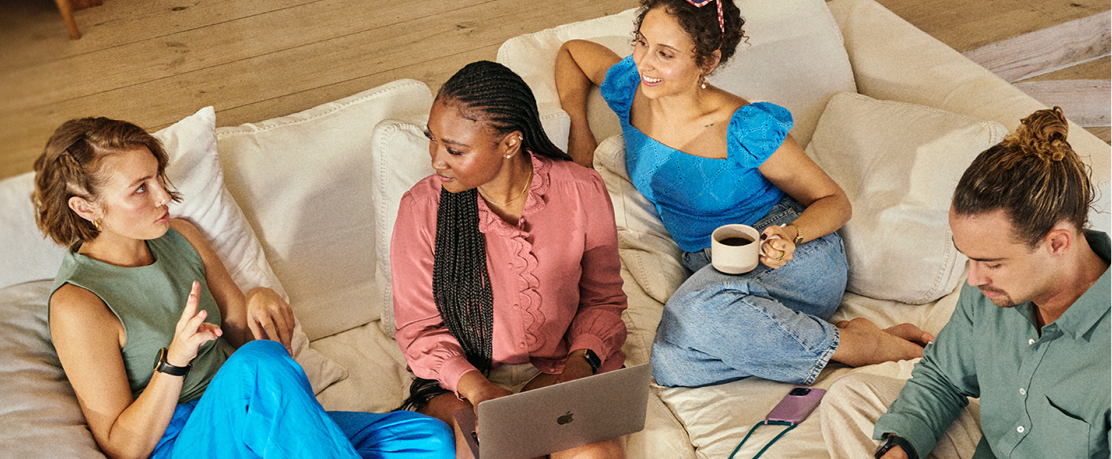What's video storytelling? 16 ways to use it in your marketing

A great story has conflict, resolution and heart—and the best ones keep it real. Whether you're inspiring with a customer journey or teasing a product drop, Superside’s creative experts help brands craft video stories that actually stick. Because attention is earned, not given. Ready to roll?
We used to etch them into cave walls, now we post them to TikTok. They’re the reason we pay $15.95 for popcorn, donate $25 to a colleague’s GoFundMe—they’re even why we fall in love. Stories are the backbone of all media, and they’re the most powerful form of communication.
Video storytelling is how effective businesses tell stories in the digital age. It’s becoming increasingly popular, as it enables a more immediate connection with potential customers. When brands combine the power of storytelling with the savviness of video marketing, it can make for a dynamic way to reach new audiences and re-engage your current ones.
Here we’ll get the story on storytelling, and learn how you can use video storytelling to grow your business through marketing.
Ready to dive in?
What do we mean by “Storytelling”
Why do we find some stories captivating and others trite?
Whether it's a funny anecdote like our video above or a spine-tingling horror story, a good story flies us away from the campfire and into the teller’s world.
Likewise, a convoluted/poorly told story has the opposite effect: We don’t believe a word, and would rather get back to burning our marshmallow in peace.
A good story usually ticks three boxes: conflict, resolution and emotion.
Conflict provides the tension and drive that keeps us turning the page (or tuning in to the next episode), while resolution gives us a sense of satisfaction and closure. Think of the villain raising their sword over our hero’s head, only to be struck down at the last moment by a supporting character we’d thought dead.
Emotion is what makes us care about the characters. We see ourselves in their struggle, and imagine feeling the same in their shoes. Whether we're laughing at a character's slapstick mishaps or wounded by their tragic backstory, these three elements allow us to connect with a story.
Why is storytelling so important to marketing?
Good storytelling rallies us to see the side of whoever has the conch shell. We synchronize with our narrator. It’s the reason we’ll root for an antihero, ignoring the subtle sense that they should probably be in jail.
For marketers, stories can motivate people to make a purchase and increase positive attitudes toward a brand. In fact, 76% of businesses say that video has helped them increase sales.
What is video storytelling?
Video storytelling is—wait for it—a story told through video.
Businesses and organizations use video storytelling to promote their products, services and causes. When crafting a video story, it’s important to think about:
- What do you want to achieve?
- Who is your audience?
- What is the message you want audiences to take home?
- How do you want the audience to feel?
Once you’ve answered these questions, you can begin planning your video.
A good story doesn't necessarily need fancy production values. Often, the simplest videos are the most effective. The most important thing is that your story is honest and authentic. Connecting with your audience on a personal level is all that’s needed to create a lasting impression.
How to make a video that tells a compelling story in 4 steps
Making a good storytelling video requires careful planning and execution. Here are some tips to help you get started.
- Choose a compelling story. The best stories are those that are personal and relatable. Think of what sort of things excite you or tug at your heartstrings. If you can find a way to connect your story to the viewer, they’ll be more likely to engage with it.
- Keep it short and sweet. No one wants to watch a long, drawn-out video. Aim for 3-5 minutes, and bear in mind that users on different platforms have varying expectations. A viewer on YouTube may watch a longer video, but on Instagram, they’ll dip out after 60 seconds.
- Use strong visuals. A good story will paint a picture in the viewer's mind, so make sure your visuals are evocative. Unless you’re Tarantino, a static video of two people sitting in chairs talking to one another is going to be a big ask from your viewer. That doesn’t mean there isn’t room for that kind of content, but adding clips, motions, stats and other visuals are often more effective for business-oriented content.
- Hire a dedicated video or editing team. It shouldn’t fall solely to your in-house marketing team to produce high-caliber video content. They’ve got goals and tasks of their own, and most don’t have the skills or resources to drive a full scale video campaign.
Video production teams like Superside can help you feel more confident and produce consistent, quality content.
4 video storytelling techniques
There are many different video storytelling techniques that can be used to create engaging and effective videos for your business.
1. The call-to-action
One common technique is known as the "call to action." This involves ending the video with a memorable statement or image that encourages the viewer to take some kind of action, such as visiting a website or signing up for a newsletter.
2. The teaser video
Another popular technique is known as the "teaser." This involves creating a short, attention-grabbing clip that whets the audience's appetite for more information.
3. The staircase method
Many video marketers use what is known as the "staircase method." This involves starting with the most important information and then gradually adding more details as the video progresses. This technique is especially effective for longer videos (over 3-5 minutes) because it helps to keep the tension rising throughout.
4. The reveal
A "reveal" is a storytelling technique in which information is slowly revealed to the audience over the course of the video. This can be done through interviews, voice-overs or text on the screen.
Given the nature of your message as a business, you may want to be careful with this one. Prospects tend to want the most important details up front, and may not appreciate a story that doesn’t make its point relatively soon.
By using one or more of these techniques, you can create a video that’s sure to leave a lasting impression on your prospects.
6 video storytelling tips and ideas
Crafting a compelling video story isn't always easy. You’ll need to find the perfect balance between informative and entertaining, without coming across as too staged or scripted. Here’s what you can do to help your video content go down smoothly.
6 video marketing storytelling examples for inspiration
The biggest brands figured out long ago how to make video storytelling work for them. Here are a few of our favorites.
1. B&W Trailer Hitches: Waterman
In this video series, B&W Trailer Hitches focuses on telling customer stories and how their products help them live extraordinary lives.
You wouldn’t expect such gripping stories to follow the purchase of a trailer hitch. But rather than talk about the specifications or durability of their product, the team at B&W focused on the reason behind the purchase of a trailer hitch: adventure.
2. LEGO
LEGO sets the bar for consumer brands in video storytelling. They’ve got an easy in, admittedly; many of us remember building colorful monstrosities with their product as children. The LEGO YouTube channel hosts entire movies showcasing the stories of LEGO fanatics, many of whom went on to work in creative professions.
3. Airbnb
Airbnb has upped its game in video storytelling recently. Their YouTube marketing videos depict real travelers’ positive experiences using the service, often honing in on Airbnb hosts themselves for a full picture of the encounter. What’s for sale here isn’t an app, but a wholesome, heartwarming memory you’ll cherish for years to come.
4. Google
It probably comes as no surprise that one of the best video storytelling companies in the world is the same brand that owns YouTube. People use Google every microsecond for wildly different reasons, so the company has free reign to tell any story they want. Here, they’ve zeroed in on a popular and easy-storified trend of family reunions via Google search. Presumably, “how to unclog a toilet” didn’t test as well.
5. Clif Bar
Clif Bar & Co. connects with its customers by telling stories that reflect their values. The company styles its products as being for the consumer on the go (images of mountain climbers adorn their packaging), meaning an image of wellness and, again, adventure is most likely to resonate with their target audience.
6. Warby Parker
The eyeglasses retailer Warby Parker is a prime example of using humor in video storytelling. In this video, employees read and share common misspellings of the company’s name. It’s cute, brightens your day 5%, and plants the suggestion of Wobbly Barker as an option for your next pair of glasses.
It’s also a case study in working your angles. They understand that their name is one of the most interesting things about their brand, and lean into it to support an image of quirkiness that prospects will associate with them. Rather than ignore their silly-sounding name, they’ve turned it into a brand asset.
How to take video storytelling to the next level
If going it alone, it can take some time to implement a video marketing plan that works for you.
Once your first videos are up, you’ll probably have to tweak things based on your results.
With some experience, you can begin trying more advanced techniques that guarantee attention-grabbing content. Here are some tips that’ll help strengthen your video marketing plan.
1. Define your metrics
Understanding the performance of your videos is vital to figuring out what’s working and what’s not.
Besides the view count, it’s good to know how long viewers are watching and if/how they’re engaging with them. Fortunately, video hosting and social platforms like YouTube, Instagram and Facebook offer these metrics in easily understood dashboards.
After a few months online, see where those figures move and adjust your videos accordingly.
2. Hop on trends
One of the best ways to evolve your video storytelling is to see what other brands and content creators are doing. What in their videos draws you to them? Why are they effective? How are audiences responding?
Trends are trends for a reason: When something works, everyone wants in. Take what you see others doing and apply it to your business. If you’re unsure how to go about this, watch videos from your favorite businesses and try making a video in the same style.
Note that we said “style”: Be careful not to steal their property or send your viewers to their website by mistake.
3. Hire experts like Superside to help
If you don’t have the time or resources to become a video marketing expert (most don’t), there’s no substitute for experience.
Superside dedicates talented professional creative teams to making compelling marketing videos.
The cost of making effective videos is far more reasonable than it used to be, and partnering with a quality team means not having to purchase equipment or studio time yourself. Teams even ensure peak performance by fitting it neatly into your business’s marketing strategy.
Video storytelling is a powerful way to connect with your audience and relay your message. Good storytelling sharpens the tools already in your toolbox (strong visuals, graphics, etc.), resulting in content that informs, entertains and strengthens your brand. Keep these tips in mind as you plan your next video marketing campaign.
We know a thing or two about video storytelling. Talk to a Supersider today!
FAQs
You may also like these

Video Production Consulting Firms & Costs for Brands in 2026
Nearly every marketer today (95%) agrees that video is essential to their digital marketing strategies. Yet more than a third admit they don’t even know where to start.That’s because truly superb video doesn’t just happen. It takes sharp creative vision, flawless execution and a team with the bandwidth to deliver at the speed and scale the market now demands. Most in-house teams simply can’t do it all.That’s where video production consulting comes in. With external strategists, creative directors, editors, animators and producers working in sync, the right partner can help you capture attention, keep your audience engaged and drive significant ROI.At Superside, for one, we go well beyond basic video production to help our customers get eyes on their brands. From in-depth brand discovery sessions and strategy development to narrative planning and creative execution, we act as a true partner on any video consultation project that comes our way.In this article, you’ll learn how to choose the perfect video production consulting service for your enterprise, what to look for in a long-term partner and which firms lead the way right now.
16 best B2B SaaS video examples from 2025
Today’s SaaS customers don’t have time to read 50-page whitepapers or sit through lengthy presentations. They skim, compare and decide on a product in a matter of minutes.With video, you can quickly demonstrate your value and drive more free trials and subscriptions. In fact, 93% of B2B buyers say video builds brand trust, and 91% of consumers feel more confident to purchase a product after they’ve watched a video.In 2026, a successful SaaS video strategy engages prospects at every stage of the marketing funnel and cuts through the noise in a crowded market. Explainer videos can, for example, build initial brand awareness, while product demos can deepen consideration. Shorter demos, feature deep dives and launch videos that also serve as PR tools now reign supreme.Already feeling a tad overwhelmed? We get it. It’s tough to produce a consistent stream of high-quality video, especially if your in-house team is stretched to the max.Let’s first explore the types of SaaS videos that work like a charm and unpack 2025’s best SaaS video marketing examples to inspire your 2026 video strategy.
8 best video post-production services of 2025
Welcome to post-production, the stage in the video production process where raw footage becomes visual content that connects, delights and drives results. Here, editors, colorists, sound designers, animators and advanced technology work in concert to transform ideas into powerful visual stories.Today’s customers expect both authenticity and quality in the videos served in their feeds. User-generated content (UGC) can increase conversions by over 161%. Combine this format with professionally edited content, and you can expect even higher video engagement.But excellent video production can be resource-intensive, and many marketers (37%) admit they don’t quite know where to start. At the enterprise level, it also takes a skilled team (adept at everything from planning, editing and performance analysis to motion design and sound engineering) to create videos that drive ROI. In many instances, teams lack the skills or simply don’t have the capacity.If you’re on the hunt for a flexible video production partner who can help you up your views and shares, you’ve found the right page. In this article, we unpack how to choose a video post-production partner, what these companies should offer you and who the best picks are right now.How to choose a video post-production company
















